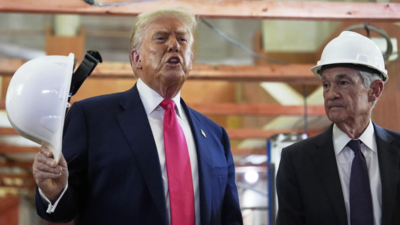ARTICLE AD BOX

The battle over the independence of the US Federal Reserve has intensified, with President Donald Trump openly calling for the resignation of a governor, threatening to fire Chair Jerome Powell, and repeatedly pressuring the central bank to cut interest rates.
The escalating confrontation has revived a long-running debate over why the Fed has historically been insulated from direct White House influence — and why markets, economists, and past experience suggest that independence is critical.This week, Trump demanded that Fed governor Lisa Cook step down after a mortgage fraud allegation, which she has flatly denied, saying she would not be “bullied” into leaving her post.
The move came just ahead of Powell’s much-watched speech at the annual Jackson Hole economic symposium, his last as chair before his term ends in May 2026.The Fed, which sets interest rates and manages the world’s largest economy’s monetary policy, has long been one of Washington’s few independent power centers, AP reported. But Trump has repeatedly railed against Powell for refusing to cut borrowing costs, arguing that high interest rates are slowing growth and raising the government’s debt-servicing bill.
At one point, the president even accused Powell of mismanaging a $2.5 billion renovation of the Fed’s headquarters, an allegation that economists dismissed as political theatre.Markets watch as Powell holds groundFor Wall Street, Powell’s stance matters. The Fed has kept its benchmark rate at 4.3% for five straight meetings, a level meant to tame inflation but one that also keeps mortgages, auto loans, and business borrowing expensive. Powell has said the central bank needs more time to assess the impact of Trump’s sweeping tariffs on inflation and growth.But the economic picture has grown murkier. July’s jobs report showed weaker-than-expected hiring, casting doubt on Powell’s earlier description of the labour market as “solid.” Inflation, meanwhile, ticked higher in July, with core prices rising 3.1% from a year ago — above the Fed’s 2% target. That leaves Powell trapped between sluggish employment that argues for a rate cut and stubborn inflation that argues against it.Most economists expect Powell to hint at a possible cut later this year without committing to one in September, disappointing investors who have priced in an earlier move. “The dilemma that the Fed is in has become, if anything, more intense,” said David Wilcox, former Fed economist and now senior fellow at the Peterson Institute.Why Fed independence mattersThe stakes go beyond one rate decision. Economists warn that allowing a president to dictate monetary policy could undermine confidence in US markets, push up government borrowing costs, and stoke inflation.
The Fed’s credibility rests on its ability to make unpopular decisions when necessary, such as raising rates even when politicians want easy money.That lesson was seared into economic memory in the 1970s, when then-Fed Chair Arthur Burns, under pressure from President Richard Nixon, kept rates low heading into the 1972 election. Inflation spiralled, and the US endured years of economic pain. It took Paul Volcker, appointed by President Jimmy Carter in 1979, to impose brutally high rates of nearly 20% — triggering a deep recession but ultimately taming runaway prices.
Volcker’s defiance is now seen as a defining example of why central banks must stand apart from day-to-day politics.Trump’s pressure campaignTrump has made little secret of his frustration with Powell. He has accused him of mishandling inflation, mismanaging Fed operations, and blocking growth. At a recent tour of the Fed’s renovation project, Trump tried to publicly embarrass Powell by claiming costs had soared to $3.1 trillion, a figure Powell calmly dismissed as including unrelated expenses.The president’s attacks are unusual in their intensity, though not unprecedented. Past presidents, from Lyndon Johnson to Ronald Reagan, have privately leaned on Fed chiefs. What sets Trump apart is his willingness to air those grievances in public and to threaten removal of officials whose terms are protected by law.Legal experts say the president cannot fire a Fed chair simply for policy disagreements. The Supreme Court has signaled that removal would require “cause” — such as misconduct or negligence.
That may explain why Trump has focused on the renovation controversy as a potential pretext. Still, any attempt to oust Powell would likely spark a court battle and roil global markets.How much control presidents really haveDespite its independence, the Fed is not unaccountable. The president appoints all seven members of its governing board, subject to Senate confirmation, and over time can reshape policy direction. Trump will get his chance when Powell’s term ends in May 2026.Congress also has a role: in 1977, it gave the Fed its “dual mandate” to pursue stable prices and maximum employment. The chair must testify before lawmakers twice a year, offering public explanations of the Fed’s decisions.For now, however, Powell and his colleagues retain their votes on interest-rate policy. Even if Trump replaced Powell tomorrow, the 12-member rate-setting committee could still resist political pressure.
That is precisely why markets prize Fed independence: it makes decisions more predictable, less politicized, and more credible.Powell’s balancing actAs Powell prepares to deliver his Jackson Hole speech, he faces one of the most delicate balancing acts of his career. The Fed must decide whether to prioritize cooling inflation, which risks choking growth, or cutting rates to cushion a slowing economy, which risks igniting prices.Either way, his words will be parsed by investors, politicians, and global markets alike. For Trump, the stakes are political; for Powell, institutional. For the Fed, it is about preserving a legacy of independence that, economists say, has safeguarded US stability for decades.



.png)
.png)
.png)
















 1 hour ago
2
1 hour ago
2









 English (US) ·
English (US) ·